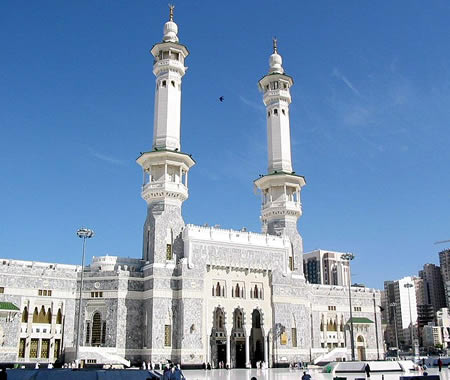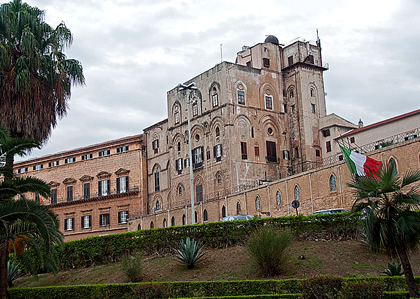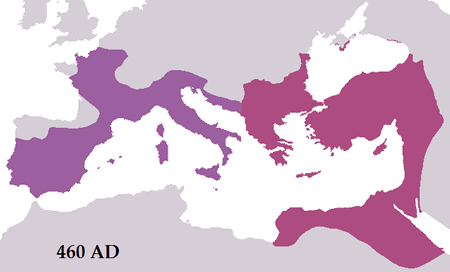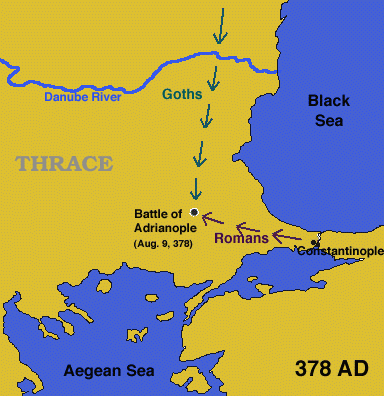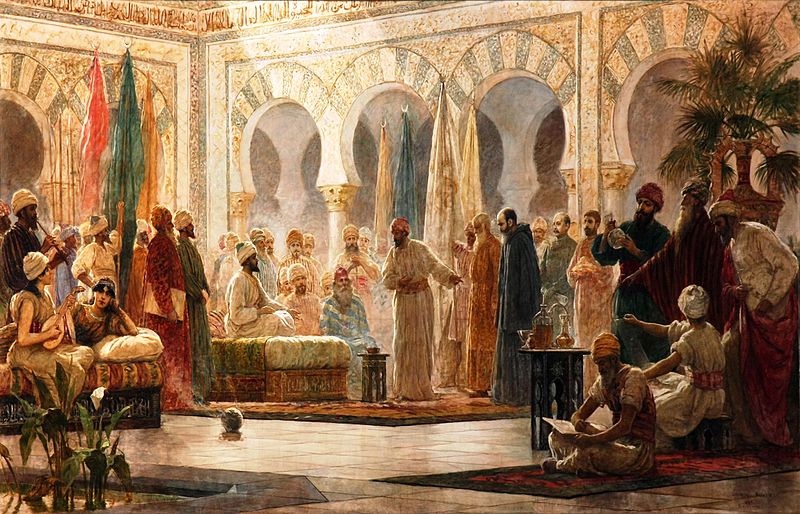 |
| Byzantine architecture |
Byzantine history spans the period from the late Roman Empire to the beginning of the modern age. Constantine the Great, first Christian ruler of the Roman Empire, moved his capital to Byzantion in 330, renaming the city Constantinople. The state he ruled was Byzant, but the citizens called themselves Rhomaioi (Romans).
The Byzantine Empire was heir to the Roman Empire. With the passage of time Byzantine civilization became distinct, as Greek influence increased and it dealt with the cultural impacts of Europe, Asia, and, after the seventh century, Islam.
During the Middle Ages, when the concept of Europe developed, Byzantium was in decline and isolated from the West. Thus Europe came into being without Byzantium, the successor to the Roman Empire. By the time Europe was a full-blown concept, Byzantium was no longer a remnant of the Roman Empire, and Constantinople was part of the Ottoman Empire.
Historical Background
Constantine established Constantinople as Rome’s capital, so the fall of Rome to the Goths did not end the empire, it merely relocated its center. Byzantine culture was a continuation of classical Greece and Rome but was distinctive in the way that it synthesized those influences with European and Islamic ones.
The early Byzantine period saw the replacement of the ancient gods by Christianity and the establishment of Roman law and Greek and Roman culture. The golden age lasted until the Arab and Persian invasions in the seventh century and the iconoclasm of the eighth century. The Byzantine emperors instituted administrative and financial reforms.
Eschewing the western approach of hiring foreign troops and lacking the tax base of the West, the emperors in Constantinople kept a small military. Although the western area lacked an emperor after 476, Byzantine emperors claimed to be rulers of the entire old Roman Empire, even though Byzantium’s military was insufficient for the reconquest of the West.
For most Byzantine emperors the rhetorical commitment to recapturing Rome was sufficient. Justinian I (527–565) undertook expeditions with some success, taking North Africa and Italy, but Justinian’s wars against the Ostrogoths destroyed Italy economically, devastating its urban culture.
His wars were also a great burden on the treasury. Justinian’s successors had to focus on reestablishing Byzantine finances destroyed by Justinian. They also had to deal with Persians in the east and Germans, Slavs, and Mongolians in the west.
Heraclius I (610–641) settled Huns in the Balkans to thwart the western threat. Then he bested the Persians, ending that empire. The year of Heraclius’s ascent to the throne, in Arabia Muhammad first heard the message that would send the forces of Islam across the world. By the end of Heraclius’s reign, the Muslim threat in Syria and Persia would force Byzantine attention away from the west and toward the east and south.
After initial Muslim successes in Syria and Egypt the Muslims took Persia and pressed into Byzantium several times in the seventh and eighth centuries. Leo the Isaurian (717–741) defeated the simpulan Muslim effort to take Byzantium, and the empire stabilized. Taking advantage of unsettled conditions in the Muslim Caliphate the empire retook most of Syria and reestablished itself as dominant until the 11th century.
After besting the Byzantines at Manzikert in 1071, the Seljuk Turks controlled Byzantium’s eastern territory. Byzantium called on its coreligionists in Europe for help against the Turks, sparking the Crusades, which produced European kingdoms in Syria and Palestine and the taking of Constantinople in 1204. Byzantium continued in Greece and retook Constantinople in 1261, but the reestablished kingdom was a small city-centered entity, and Ottoman Turks absorbed it in 1453, renaming it Istanbul.
The empire was Christian but its Christianity differed from that of the West. The Latin popes won primacy in a Europe with no centralized secular ruler, but in Byzantium the emperor kept a powerful role in the church. The Byzantine retention of the Roman concept that the emperor was nearly divine would generate a split with the West, particularly through the Iconoclastic Controversy.
The Iconoclastic Controversy
During the fourth century in the Roman Empire, classical forms declined and eastern influences became more important. Constantinople became a new center for artists in the eastern part of the empire, especially Christians. Other centers included Alexandria, Antioch, and Rome. When the first two fell to the Arabs and Rome to the Goths, Constantinople was alone and supreme. The first great age came during the reign of Justinian I (483–565).
He established a code of law that imposed his religion on his subjects and set the stage for absolutism. He built the Hagia Sophia and the Church of the Holy Apostles in Constantinople and the Basilica of San Vitale in Ravenna (in Italy). After Justinian the empire declined, with Justinian’s conquests lost and Avars, Slavs, and Arabs threatening. Religious and political conflict also disturbed the capital.
In 730 Leo III the Isaurian came into contact with Islamic beliefs during his successful wars against the Muslims. Accepting the purity of the Muslim rejection of idols and images, he banned images of Jesus, Mary, and the saints. The Iconoclastic period lasted until 843. Iconoclastic theologians regarded the worship of icons or images as pagan. Worship was reserved for Christ and God, not for the product of human hands, during the Iconoclastic Controversy.
The Iconoclastic Controversy disoriented the Byzantine Church. Byzantine religious culture and intellectual life, previously known for innovation and speculation, were stagnant from that point. A wholesale destruction of art showing inappropriate figures occurred.
Restrictions on content meant that ornamental designs and symbols such as the cross were about the limit of expression. Without human figures, mosaicists borrowed Persian and Arab designs, such as florals, and the minor arts remained vibrant.
The papacy adamantly rejected iconoclasm as a threat to the authority of the pope. Leo’s son Constantine V (740–775) was more adamantly iconoclastic than Leo. Although Byzantium abandoned iconoclasm in the ninth century, the breach persisted. The end of iconoclasm brought about the Macedonian Renaissance, beginning under Basil I, the Macedonian, in 867.
The ninth and 10th centuries were times of improved military circumstances, and art and architecture rebounded. Byzantine mosaic style became standardized, with revived interest in classical themes and more sophisticated techniques in human figures.
After the Iconoclastic Controversy resolved itself in favor of using icons, the empire flourished from 843 to 1261. During this period the arts prospered, the official language was Greek, and Christianity solidified its hold from the capital through the northern Slavic lands.
Afer the Macedonians came the Komnenian dynasty, starting in 1081 under Alexios I Komnenos. This dynasty reestablished stability after the major dislocations of Manzikert, which cost Byzantium Asia Minor. Between 1081 and 1185 the Komnenoi patronized the arts, and a period of increased humanism and emotion occurred. Examples are the Theotokos of Vladimir and the Murals at Nerezi. As well as painted icons, this period saw mosaic and ceramic examples, and for the first time the iconic form became popular through the empire.
Excellent Byzantine work of this period is also found in Kiev, Venice, Palermo, and other places outside the empire. Venice’s Basilica of St. Mark, begun in 1063, was modeled on the now destroyed Church of the Holy Apostles in Constantinople. The Crusades, specifically the massacre of Constantinople in 1204, ended eight centuries of Byzantine culture. The Frankish crusaders of the Fourth Crusade pillaged Constantinople, generating even more destruction of Byzantine art than did the iconoclastic period.
Palaeologan Mannerism
The state reestablished in 1261 included only the Greek Peninsula and Aegean Islands. After the crusader period (1204–61), Byzantium had a simpulan surge until the Ottoman conquest. The simpulan bloom of Byzantine art, the Palaeologan Mannerism, occurred under the Palaeologan dynasty, founded by Michael VIII Palaeologus in 1259.
This periode saw increased exchange between Byzantine and Italian artists, new interest in pastorals and landscapes, and the replacement of masterful mosaic work such as the Chora Church in Constantinope by narrative frescoes. Byzantine culture included women and men alike, unlike practices in classical Greece and Rome or in medieval Europe.
Women could not attend school, but aristocratic females received tutoring in history, literature, philosophy, and composition. The greatest Byzantine writer was the female historian Anna Komnene, whose biography of her father, Emperor Alexios, is among the best of medieval histories.
Byzantine art was underpinned by the art of ancient Greece, and until at least 1453 it remained strongly classical yet unique. One difference was that the ancient Greek humanistic ethic gave way to the Christian ethic. That meant that the classical glorification of man became the glorification of God, particularly Jesus.
Byzantine art replaced the classical nude with figures of God the Father, Jesus (Christ) of Nazareth, the Virgin Mary, and the saints and martyrs. Byzantine art emphasized strongly the icon, an image of Christ, Mary, a saint, or Madonna and Child used as an object of veneration either in church or at home.
Byzantine miniatures showed both Hellenistic and Asian influences. Byzantine architecture rested on Roman technical developments. Proximity to the Hellenized East meant that Constantinople’s architecture showed Eastern influences. The Basilica of St. John of the Studion, dating from the fifth century, exemplifies the Byzantine use of Roman models. Some criticize Byzantine art as lacking in realistic depictions of humans.
Byzantine art lacked some of the naturalism of ancient Greek art. Particularly in sculpture, technical expertise declined as emphasis shifted to Christian themes. However, Byzantine art had periodic technical revivals, and it maintained enough of the Greek classical influence to allow the Renaissance to happen.
Rejecting sensual pleasure, pagan idols, and personal vanity, Byzantine artists worked to serve Christianity by showing not the external perfect human form but the internal, spiritual element of the subject. Stylized and simplified representations were appropriate to this purpose.
New techniques and new levels of accomplishment characterized Byzantine silver- and goldsmithing, enamel, jewelry, and textiles. Byzantine mosaics and icons showed high levels of originality. Architecture found its highest expression in the Hagia Sophia, superior in scale and magnificence to anything in the ancient world.
Although skill levels fluctuated over time, in most Byzantine art forms certain usages, patterns, and practices remained constant. Mosaics served as the predominant decorative art for domes, half-domes, and other available surfaces of Byzantine churches.
Byzantine painting concentrated to a great extent on devotional panels. Icons were vital to both religious and secular life. Icons lacked individuality, their effectiveness resting on faithfulness to a prototype. Byzantine painting also included manuscript illumination.
Byzantine art continues in some aspects in the art of Greece, Russia, and the modern Eastern Orthodox countries. Enamel, ivory, and metal reliquaries and devotional panels were highly valued through the Middle Ages in the West. Byzantine silk was a state monopoly and a highly prized luxury.
In Italy Byzantine art was a major contributor to the Romanesque style in the 10th and 11th centuries. In the Holy Roman Empire, Charlemagne had close ties to Byzantium; he and other Frankish and Salic emperors transmitted the Byzantine influence through their domains.
The official end to Byzantium came with the fall of Constantinople to the Ottoman Turks in 1453, but in the meantime the culture had diffused with Orthodox Christianity to Bulgaria, Romania, Serbia, and, most significantly, Russia, which took the mantle from Constantinople after 1453. The Ottomans allowed Byzantine icon painting and small-scale arts to continue.
Byzantium transmitted classical culture to Islam and to the West. More important, Byzantine culture and religion strongly influenced the Slavs, particularly the Russians. Around 988 the Russian Vladimir converted to Byzantine Christianity. When Byzantium collapsed in 1453, Russia’s rulers took the title “caesar” (czar), that of the Byzantine emperors. The Russian czar proclaimed Moscow the “Third Rome,” after Rome and Byzantium.
The Byzantines also preserved culture, pursuing science, philosophy, and classical studies. Byzantine basic education entailed mastery of classical Greek literature, including the works of Homer, largely unknown in the West. Byzantine scholars studied and preserved the works of Plato and Aristotle, making them available to first the Islamic world and then western Europe.

